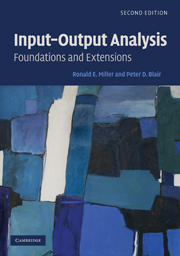Book contents
- Frontmatter
- Contents
- List of Figures
- List of Tables
- Preface
- 1 Introduction and Overview
- 2 Foundations of Input–Output Analysis
- 3 Input–Output Models at the Regional Level
- 4 Organization of Basic Data for Input–Output Models
- 5 The Commodity-by-Industry Approach in Input–Output Models
- 6 Multipliers in the Input–Output Model
- 7 Nonsurvey and Partial-Survey Methods: Fundamentals
- 8 Nonsurvey and Partial-Survey Methods: Extensions
- 9 Energy Input–Output Analysis
- 10 Environmental Input–Output Analysis
- 11 Social Accounting Matrices
- 12 Supply-Side Models, Linkages, and Important Coefficients
- 13 Structural Decomposition, Mixed and Dynamic Models
- 14 Additional Topics
- Appendix A Matrix Algebra for Input–Output Models
- Appendix B Reference Input–Output Tables for the United States (1919–2006)
- Appendix C Historical Notes on the Development of Leontief's Input–Output Analysis
- Author Index
- Subject Index
14 - Additional Topics
Published online by Cambridge University Press: 05 June 2012
- Frontmatter
- Contents
- List of Figures
- List of Tables
- Preface
- 1 Introduction and Overview
- 2 Foundations of Input–Output Analysis
- 3 Input–Output Models at the Regional Level
- 4 Organization of Basic Data for Input–Output Models
- 5 The Commodity-by-Industry Approach in Input–Output Models
- 6 Multipliers in the Input–Output Model
- 7 Nonsurvey and Partial-Survey Methods: Fundamentals
- 8 Nonsurvey and Partial-Survey Methods: Extensions
- 9 Energy Input–Output Analysis
- 10 Environmental Input–Output Analysis
- 11 Social Accounting Matrices
- 12 Supply-Side Models, Linkages, and Important Coefficients
- 13 Structural Decomposition, Mixed and Dynamic Models
- 14 Additional Topics
- Appendix A Matrix Algebra for Input–Output Models
- Appendix B Reference Input–Output Tables for the United States (1919–2006)
- Appendix C Historical Notes on the Development of Leontief's Input–Output Analysis
- Author Index
- Subject Index
Summary
Introduction
There has been an enormous output of research, developments, extensions, and applications of input–output models in the decades since the late 1940s and early 1950s, when the subject first entered an academic curriculum at Harvard University. The increasing capacity and speed of modern computers has contributed to this work by facilitating large-scale data-intensive experiments that were unthinkable in the early days. Throughout the text we have identified many of these extensions and applications, but there are many topics that we have not been able to include or reference in the preceding chapters. So, in addition to those topics to which we have referred but not developed further for one reason or another in previous chapters, here we explore several additional areas, primarily to give some possible guidance to the relevant literature, should the reader wish to explore one or more of these topics. (To sort out the appropriate literature, we depart from the practice in earlier chapters and include references at the end of each individual section.)
In particular, in this chapter, we survey a number of topics that presently are either frontier areas in input–output analysis or that relate input–output to other types of economic analysis that we have not included or only briefly addressed in previous chapters. We do not cover these topics in as much detail as those covered in previous chapters, in some cases because the topic involves methods beyond the scope of the present volume, such as statistics, econometrics, or mathematical programming.
- Type
- Chapter
- Information
- Input-Output AnalysisFoundations and Extensions, pp. 669 - 687Publisher: Cambridge University PressPrint publication year: 2009



